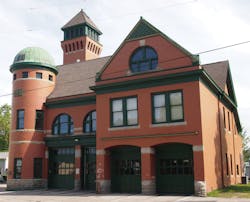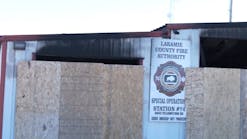MI Fire Station Goes into Record Books
By David L. Barber
Source Firehouse.com News
Sometimes, history is best preserved in a jar.
And so it is at the Manistee Fire Department, located in northwestern Michigan, where a decades-old glass jar serves as a sarcophagus for slivers of grain that filtered down through its floorboards over the passing cavalcade of years. The oats were once a nourishing treat for the department's team of horses during the era that bridged the 19th and 20th centuries.
Fortunately, neither the jar of grain, nor the building, itself, have been lost to the cobwebs of time. On June 17, 2019, the majestic Romanesque Revival-style building that is still operational was officially recognized by Guinness as the Oldest Continuously Manned Operating Fire Station, in the world. Since then, more and more visitors have requested tours of the historic firehouse, something the Manistee firefighters thoroughly enjoy being honoring and being part of.
Longtime firefighter Fred LaPoint, who retired July 1 after nearly 40 years with the department, led the years-long charge to gain the building the Guinness distinction.
“History is not something which is obscure, or unimportant,” LaPoint said. “History plays a vital role in our everyday lives. We learn from our past in order to achieve greater influence over our future.
“History serves as a model, not only for who and what we can become, but we can also learn what things we should champion and what things we should avoid. Every day, decision-making around the world is constantly based upon what came before us.”
Over the past few years LaPoint gathered a basket of printed information – newspaper clippings, records, photos and more – that he sent to Guinness historians for verification.
“The Manistee Fire Station continues to tell the stories and carry the memories of all the firefighters who came before, including those currently serving and those who will serve in the future,” LaPoint said. “The station holds, within its walls, the answers to questions like the why horses were introduced into the fire service, how water was supplied to the steam fire engines long before the use of tank trucks and portable ponds, why the Dalmatian became the preferred breed around the firehouse, and how the citizens were able to contact the fire department for emergencies to report an alarm of fire or medical emergency long before telephone service, or 9-1-1 dispatch came into existence.
“It tells the story about the pride, dedication, and commitment of the firefighters who have proudly served your city and county since the fire department's formation in October of 1869, and the Manistee Fire Station's opening June 17, 1889.
“It has been my hope that by receiving recognition through the Guinness World Record, that these puzzle pieces of our history will serve not only to educate and inform, but will upend what it is we thought we knew and remind us of the importance of our past history,” he said. “Old places like the City of Manistee Fire Station matter because they give us a deeper appreciation and understanding of our past – an understanding that written documents alone never could.”
If the time-honored fire hall has passed and even surpassed the test of time, consider this: its incredible survival and achievement record notwithstanding, it was constructed bottom to top in a matter of only a few months, and cold, harsh Northern Michigan winter months, at that. Funds to finance its construction were authorized in October, 1888, and, quite incredibly, the fire hall was ready for occupancy the following June.
It helped greatly that at that time Manistee was one of the preeminent lumbering communities in the Midwest. Just about all the materials used to build the fire hall were resourced from local lumber, brick-making and iron-casting companies. Most of the workers lived within walking distance.
Though the fire hall is advertised in a promotional pamphlet as “a two-story, cross-gabled, Romansque Revival-style building,” it actually has six unique levels. The lower level that once held horses, steam engines, hose carts and water tanks – all pulled on wooden wheels – is now home to the department's medical response vehicles and fire trucks.
The garage doors that once opened wide to release its horse and cart teams today allow just under two inches for the side mirrors of the fire trucks to be cleared for response and return.
From the beginning, the second floor was fitted with eight beds for on-watch firefighters – though just two routinely staff the building today – a kitchen, dining area, desk and study area, and in its early years, a coal storage area and another room that contained horse feed that was dropped down through one of four small trap doors to the horses, below, or that fell through the cracks in the floor, itself, in the following years. That area now serves as a work-out and weight-lifting room for the firefighters.
Ascending upward into the darkened, square, castle-like tower via a series of narrow, steep, winding stairwells “that weren't made for big or tall men,” said firefighter Daniel Reck, is a fourth level where fire hoses are drawn up with ropes and pulleys, and then strung to the ground floor in their 50-foot lengths so they can drip and dry out.
Above the hose-drying loft is another level where a large bell still hangs – a bell that once sounded alarms. It was also rung at 7 a.m. daily to alert children their schools would soon open, and again at 9 p.m. to inform those 16 years old and under it was time to be home according to a city-mandated curfew of the times.
And, at the very top of the 88-foot tall tower – above even the bell, itself – is a unique sixth level from where firefighters kept a 360-degree lookout over their city for any sight of smoke or fire during inclement weather and extreme dry conditions.
Two brass poles that firefighters slid down for quick access from their second-floor quarters to where their horses, hose carts and water wagons were stored on the ground floor are still in place, but are only used if today's firefighters need a secondary way to escape the upper floor should an emergency occur within their own building. Still, every Friday, a firefighter uses a 10-foot ladder to polish the poles.
Today's Manistee firefighters, divided into three shifts, work 48 hours on, and then have 96 hours off. Because they are also trained paramedics the majority of their calls are medical related, and not fire.
But whatever emergency call they respond to, the department's history remains history making.
“In early October of 1888, bids were advertised ... the lowest at $7,516,” said Mark Fedder, executive director of the Manistee County Historical Museum. That bid and ensuing cost for construction – from the first brick that would be put down, to the last roofing tile being tacked into place – came at a time when, according to the Bureau of Labor Statistics, the average worker in America was making about $1.55 a day, or about $430 a year.
Fedder said after the bid was awarded, “the Manistee Democrat, one of the city’s newspapers, noted that the fire department building, 'will be a credit to the city' and that 'it will be a beauty and a model of convenience and usefulness.'”
“During the past week the fire department have been moving into their new building … the furnishing of the building is not completed, but when it is finished, Manistee will have as fine and convenient quarters for her firemen as can be found in the state,” the long defunct newspaper reported in its June 21, 1889 edition.
That story quoted the fire chief of the time as saying: “the stables (are) arranged that at the sound of the alarm bell, the doors will be thrown open by electricity, the horses can instantly take their places, the driver mount to his seat … in a very small part of a minute ... watch will be kept in the tower during stormy nights, or on occasions when unusual precaution is deemed necessary.”
Timothy Kozal, Director of Public Safety for the City of Manistee, also wears both the caps of police chief, and fire chief.
“One-hundred-thirty years ago Chief (Constantin) Fleissner opened the doors of this station,” Kozal said at the June 17 unveiling of the Guinness plaque. “One can only imagine the stories, the training, the sleepless nights, and how they communicated to shape the fire department.
“Fred approached me about the possibility of pursuing the Guinness world record for the oldest continuously operated and manned fire department. I was intrigued. Fred spent considerable time on the project. Several times I'd stop in and discuss progress and offer assistance. I am very proud of Fred and his diligence to the cause. He has a passion for what he does. He has a passion for history and what we represent.”
Kozal said he also is pleased members of his police department, including himself, are cross-trained to provide fire support, also.
“We are always growing as a fire department,” Kozal said. “I stress to the team that we are a service organization and we are to provide the exemplary customer service to each and every person we meet. We always meet at the table each and every day. We discuss how we can do better. We debrief. We listen to each other. We are inclusive. As part of our growth as a full-time fire department, each firefighter went back to school and (became) licensed as paramedics.
“To that end, in 2013 we advanced our level of service to the community by transitioning to an Advance Life Support agency. We continue to take great strides in our training and advancing our partnerships with our neighboring fire departments.”
Fedder also spoke at the community's June 17 ceremony that unveiled the Guinness plaque.
“The Manistee community has always been proud of this building and its firefighters, and this designation makes it all the more special,” said Fedder, who encouraged city leaders to continue their work. “I would urge them to continue to respect the past and to rightfully preserve the history of our community. Because, without these preservation efforts, none of us would be standing here today commemorating this magnificent building that is only special to Manistee.”
LaPoint, who for years has donned a 19th century firefighter's uniform to walk in the city's horse-and-carriage Victorian Festival Christmas Parade with his Dalmatian, Blaze, by his side, said he is pleased with the department's most recent historic distinction. It previously had been awarded State of Michigan Historic Site status.
“I have been blessed to see some incredibly beautiful and awe-inspiring treasures preserved within historical museums, historical societies, libraries, national parks, and historical sites,” LaPoint said. “The common thread running through each one of these is that each serves not only to preserve our heritage, but they also tell a story. They are a record of who we are, where we came from and what we are today. But increasingly, these treasures are being lost, not to fire, flood, or natural disaster, but by neglect.”
Captain John Peddie has been with the department for nine years.
“Every time I stop for a minute and look around, it seems I see something unique, something different, something of real historical significance, that I didn't see before,” Peddie said. “I continue to be amazed at just how solid this building is, how beautiful it is.
“Of course it's a wonderful, historic building, but it's still a reliable, working fire department, too. It continues to serve its intended purpose.”
Located in one corner of the fire department is a room that holds a number of historic items: photos, records, maps, books, badges, caps, a period fire hydrant and more. And tucked away in a secured area is an otherwise innocuous jar of oats.
“When I first started about 40 years ago we had an old-timer – a nice gentleman – who would ride his bicycle to the station and sit down and talk with us,” LaPoint said. “He told us that to the best of his recollection, the last time they had horses there was about 1917, during a real cold winter. He remembered that.”
Those horses, LaPoint said, had been fueled by the oats that had been lifted into the loft above them, and then dropped back down into their dinner troughs. Over the years and decades, as those slivers of oats sifted their way down through the floorboards between the long abandoned second-floor loft and bygone first-floor horse corral, they were picked up, one and two at a time, and spirited away into their glass jar for all posterity.
“History,” LaPoint said of the jar and its contents. “History.”






